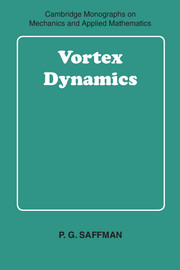Book contents
- Frontmatter
- Contents
- Preface
- 1 Fundamental properties of vorticity
- 2 Singular distributions of vorticity
- 3 Vortex momentum
- 4 Motion with surfaces
- 5 Some applications
- 6 Creation of vorticity
- 7 Dynamics of line vortices in two-dimensional flow
- 8 Vortex sheets in two dimensions
- 9 Dynamics of two-dimensional vortex patches
- 10 Axisymmetric vortex rings
- 11 Dynamics of vortex filaments
- 12 Three-dimensional vortex instability
- 13 Effects of viscosity
- 14 Miscellaneous topics
- Epilogue
- References
- Index
Preface
Published online by Cambridge University Press: 05 August 2012
- Frontmatter
- Contents
- Preface
- 1 Fundamental properties of vorticity
- 2 Singular distributions of vorticity
- 3 Vortex momentum
- 4 Motion with surfaces
- 5 Some applications
- 6 Creation of vorticity
- 7 Dynamics of line vortices in two-dimensional flow
- 8 Vortex sheets in two dimensions
- 9 Dynamics of two-dimensional vortex patches
- 10 Axisymmetric vortex rings
- 11 Dynamics of vortex filaments
- 12 Three-dimensional vortex instability
- 13 Effects of viscosity
- 14 Miscellaneous topics
- Epilogue
- References
- Index
Summary
In the past three decades, the study of vortices and vortex motions – which originated in Helmholtz's great paper of 1858, ‘Uber Integrale der hydrodynamischen Gleichungen welche den Wirbelbewegungen entsprechen’ (translated by Tait [1867]), and continued in the brilliant work of Lord Kelvin and others in the nineteenth century, and Prandtl and his Göttingen school in the first half of this century – has received continuing impetus from problems arising in physics, engineering and mathematics. As aptly remarked by Küchemann [1965], vortices are the ‘sinews and muscles of fluid motions’. Aerodynamic problems of stability, control, delta wing aerodynamics, high lift devices, the jumbo jet wake hazard phenomenon, among other concerns, have led to a myriad of studies. Smith [1986] reviews some of this work. The realisation that many problems involving interfacial motion can be cast in the form of vortex sheet dynamics has stimulated much interest. The discovery (rediscovery?) of coherent structures in turbulence has fostered the hope that the study of vortices will lead to models and an understanding of turbulent flow, thereby solving or at least making less mysterious one of the great unsolved problems of classical physics. Vortex dynamics is a natural paradigm for the field of chaotic motion and modern dynamical system theory. It is perhaps not well known that the father of modern dynamics and chaos wrote a monograph on vorticity (Poincaré [1893]).
- Type
- Chapter
- Information
- Vortex Dynamics , pp. xi - xivPublisher: Cambridge University PressPrint publication year: 1993

